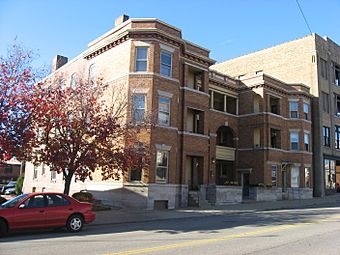Adena Court Apartments facts for kids
Quick facts for kids |
|
|
Adena Court Apartments
|
|

Front of the apartments
|
|
| Location | 41 S. 4th St., Zanesville, Ohio |
|---|---|
| Area | less than one acre |
| Built | 1906 |
| Architectural style | Colonial Revival |
| NRHP reference No. | 80003190 |
| Added to NRHP | September 27, 1980 |
The Adena Court Apartments are a cool old apartment building in downtown Zanesville, Ohio, United States. They were built way back in 1906. These apartments are a great example of a building style called Colonial Revival. This style was popular in the early 1900s.
Contents
What Makes These Apartments Special?
The Adena Court Apartments are special because they show off a classic building style. The Colonial Revival look brings back ideas from early American homes. Think of grand houses with balanced shapes and fancy details. This building has kept its original look very well over the years.
Who Built the Adena Court Apartments?
A doctor named Charles M. Lenhart had these apartments built. He was a very important doctor in Zanesville. Dr. Lenhart was born in the countryside of Muskingum County. He worked at two hospitals in Zanesville. He also had his own doctor's office in the downtown area.
A Doctor's Dream Building
When Dr. Lenhart decided to build apartments, he wanted them to fit with his old property. The main part of the new building actually included his original house and office! We don't know who the architect was. But they designed the building using strong brick for the outside. They also added cool details made of stone and metal. Once the building was finished, Dr. Lenhart and his family moved into one of the apartments. Another part of the building became his new doctor's office.
Why Are They a Historic Landmark?
In 1980, the Adena Court Apartments were added to the National Register of Historic Places. This is a special list of buildings, sites, and objects that are important in American history. The apartments earned this spot because their old architecture was so well-preserved. It means they still look a lot like they did when they were first built.



